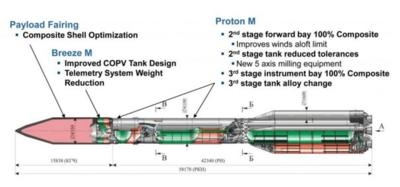Wed, Feb 17, 2016
Engineers Proceeding With LV Stages In Preparation For Launch
The Proton-M launch vehicle earmarked for the Russian-European ExoMars-2016 mission has been delivered to Baikonur. The Proton-M will orbit the scientific equipment including the Schiaparelli entry, descent and landing demonstrator module (”Schiaparelli”), and the Trace Gas Orbiter module.

To inject the scientific equipment in the target orbit, the Proton-M ILV will use the Breeze-M upper stage. The launch of the mission spacecraft is scheduled for 14 March 2016.
The train carrying the launcher stages was transferred to the Integration & Testing Facility in Area 92?-50 last week. There, Roscosmos and Khrunichev specialists will proceed with the mating of the LV stages and preparations for the launch.
The heavy-lift Proton and the Breeze-M upper stage were designed and are serially manufactured by the Khrunichev Space Center. The system is used to insert payloads to low-earth orbits and escape trajectories on missions under the federal and commercial programs. The system is marked for its high performance characteristics. Outfitted with the Breeze-M Upper Stage, the modernized Proton-M is capable of providing a geo-transfer injection for payloads with a mass in excess of 6MT.
ExoMars is a joint project of the Roscosmos State Corporation and the European Space Agency (ESA). The Trace Gas Orbiter will study small quantities of gas impurities in the atmosphere and distribution of water ice in the soil of Mars using also Russian scientific equipment designed at the Institute for Space Research of the Russian Academy of Sciences. The orbital module will also retransmit data from the descent demonstrator module of the 2016 mission, and from the descent module and Mars rover vehicle of the 2018 mission.
The Schiaparelli landing demonstrator is intended for verifying viability of procedures required for entering the atmosphere, descending, landing, and carrying out research using onboard scientific equipment.
(Source: International Launch Service news release. Image provided by ILS)
More News
Airport Marking Aids Markings used on runway and taxiway surfaces to identify a specific runway, a runway threshold, a centerline, a hold line, etc. A runway should be marked in ac>[...]
"It is extremely difficult, if not impossible, for manned aircraft to see a drone while conducting crop-enhancing and other aerial applications at low altitudes and high speeds. We>[...]
Aero Linx: The Skyhawk Association The Skyhawk Association is a non-profit organization founded by former Skyhawk Pilots which is open to anyone with an affinity for the A-4 Skyhaw>[...]
“The T-54A benefits from an active Beechcraft King Air assembly line in Wichita, Kansas, where all required METS avionics and interior modifications are installed on the line>[...]
Aero Linx: Aerostar Owners Association The Association offers the Aerostar Owner a unique opportunity to tap an invaluable source of information concerning the care and feeding of >[...]
 ANN's Daily Aero-Term (04.28.24): Airport Marking Aids
ANN's Daily Aero-Term (04.28.24): Airport Marking Aids Aero-News: Quote of the Day (04.28.24)
Aero-News: Quote of the Day (04.28.24) ANN's Daily Aero-Linx (04.28.24)
ANN's Daily Aero-Linx (04.28.24) Aero-News: Quote of the Day (04.29.24)
Aero-News: Quote of the Day (04.29.24) ANN's Daily Aero-Linx (04.29.24)
ANN's Daily Aero-Linx (04.29.24)



